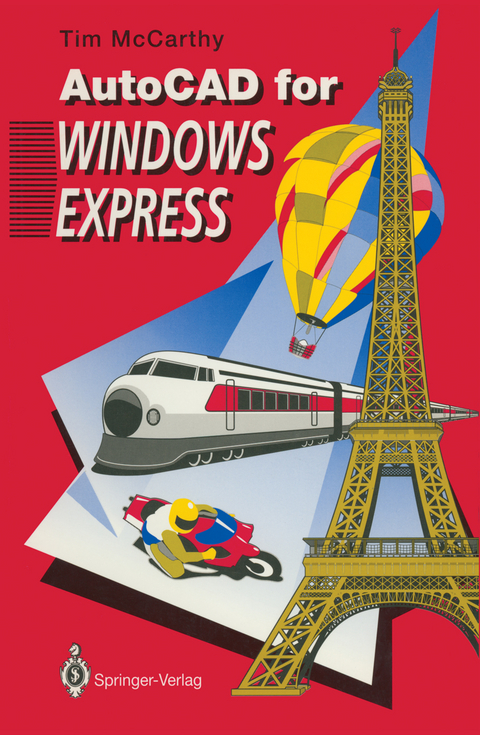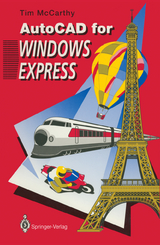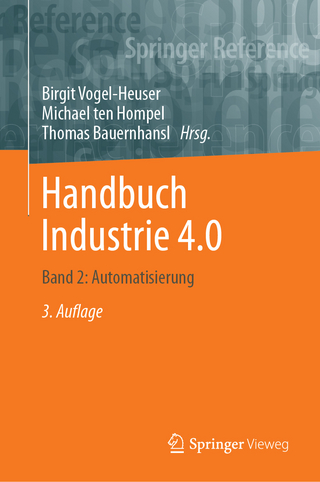AutoCAD for Windows Express
Springer Berlin (Verlag)
978-3-540-19865-9 (ISBN)
What is AutoCAD? AutoCAD is the world's most popular computer-aided drafting package for the personal computer (PC). It is a fully functional 2D and 3D CAD program. Full 3D wire frame representation was incorporated in the program with the launch of Release 10 in 1988. Release 11 brought additional 3D facilities in cluding some solid modelling capabilities. These capabilities were enhanced with Release 12 of the program for DOS and Windows. Its popularity has made AutoCAD the de facto industry standard for PC-CAD with a host of other program developers providing application software conforming to the AutoCAD format. As a fully functional drafting program, AutoCAD can achieve anything that can be drawn on a drawing board. The main benefits of CAD come more from being able to edit and exchange drawing information rapidly rather than simply replacing the drawing board. Starting to use AutoCAD is a difficult step as it requires a certain amount of new skill development. Once you have made the commitment to learn how to use the program and implement it in your everyday work the benefits will soon accrue. You will quickly discover that there are many things that you can do with AutoCAD that you could never do with a drawing board. With AutoCAD your drawings become more than just black lines on a white sheet of paper. The AutoCAD drawing is a database of information.
1 Introduction.- What is AutoCAD?.- The aims of the AutoCAD Express.- The Express route through AutoCAD.- Conventions used in the AutoCAD Express.- The Windows environment.- 2 Starting Autocad.- Preparation.- Creating a drawing.- HELP!.- Summary.- 3 Cursor and Display Control.- General.- Layers.- Cursor location.- ZOOM and PAN.- Keyboard toggles and transparent commands.- Summary.- 4 Drawing and Editing.- General.- Rubbing out and OOPS.- The balloon drawing environment.- Creating circles, arcs and ellipses.- Adding text.- Wide lines.- Shading with patterns.- Summary.- 5 Constructive Editing.- General.- Drawing the arch.- Editing a polyline with PEDIT.- Moving objects.- Copying.- Altering objects' characteristics.- Mirror image.- Multiple copies using ARRAY.- Summary.- 6 Super-Entities.- General.- Making a block.- Inserting blocks.- Global blocks.- Making a library of useful symbols.- Drawing the kitchen.- Editing attributes.- A simple bill of materials.- Hints on using blocks.- AutoCAD's inquiry commands.- Summary.- 7 Advanced Drawing and Dimensioning.- General.- Drawing a gland.- Dimensioning.- Standard dimension variable settings.- Drawing a pentagon.- Summary.- 8 Adding Depth to Your Drawings with 3D CAD.- General.- Isometric projection.- The Express State Building in 2.5 dimensions.- The Pyramids of Giza in glorious 3D.- A dynamic viewpoint on visualisation.- AutoCAD's 3D box of tricks.- AME.- Summary.- 9 The Hardcopy - Printing and Plotting.- General.- Printing and plotting.- Plotting multiple viewports in paper space.- Printing from Windows.- The softcopy.- Summary.- Appendix A: Configuration.- General.- The DOS environment.- Configuring AutoCAD.- Altering devices.- Summary.- Appendix B: Linetypes and Hatch Patterns.- General.- Linetype definition.- Hatchpattern defintiion.- Summary.
| Erscheint lt. Verlag | 10.10.1994 |
|---|---|
| Zusatzinfo | XIII, 314 p. |
| Verlagsort | London |
| Sprache | englisch |
| Maße | 155 x 235 mm |
| Gewicht | 600 g |
| Themenwelt | Informatik ► Weitere Themen ► CAD-Programme |
| Technik ► Maschinenbau | |
| Weitere Fachgebiete ► Handwerk | |
| Schlagworte | 3D CAD • AutoCAD • AutoCAD für Windows • Computer-Aided Design (CAD) • Layer • Layers • Model • Plot • Plotter • Visualization |
| ISBN-10 | 3-540-19865-2 / 3540198652 |
| ISBN-13 | 978-3-540-19865-9 / 9783540198659 |
| Zustand | Neuware |
| Informationen gemäß Produktsicherheitsverordnung (GPSR) | |
| Haben Sie eine Frage zum Produkt? |
aus dem Bereich




